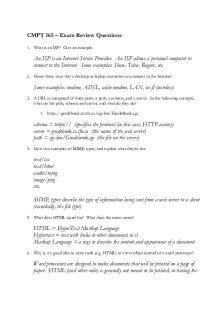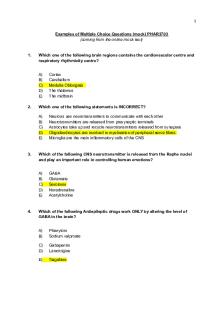Mock exam with clear questions and answers PDF

| Title | Mock exam with clear questions and answers |
|---|---|
| Course | Data Analysis |
| Institution | EDHEC Business School |
| Pages | 6 |
| File Size | 146.7 KB |
| File Type | |
| Total Downloads | 87 |
| Total Views | 153 |
Summary
mock exam to get a clear idea on how the final exam would be....
Description
Mock Exam: Data Analysis Edhec Global MBA January 25, 2020 You may use your computer with Excel for any part of this mock exam that you wish. You may also refer to your page of A4 notes. However, you may NOT open any other files or the internet at all on your computer during the exam. Any open files other than the exam Excel data file saved on the desktop will automatically mean a 0 in the final exam. All final answers must be written on paper. Answers written in text boxes or in cells on Excel will not be reviewed. On your paper refer to worksheets and charts as necessary, but all discussion must be on paper. I will collect all paper versions of the exam and you will upload your Excel files to the blackboard at the end of the exam. Before anyone leaves the room, I must double check that all files are uploaded and all paper exams turned in so I thank you in advance for your patience and your silence during this process. The data for this exam can be found on the blackboard under Exam Information in the file “January 2020 final exam data”. When you open it please save it immediately to your desktop under your lastname_firstname, for example “MAURY_Tristan.xlsx”.
Question 1 2 3 4 5 Total:
Total points 9 points 16 points 7 points 9 points 9 points 50 points
1
1) Weekday demand for “daily specials” at the EDHEC Brasserie is approximately normally distributed with a mean of 50 and a standard deviation of 9. a) Draw the distribution for “daily special” demand on this exam sheet. (2 points)
b) What is the probability that demand on a weekday exceeds 59 daily specials? (2 points)
c) What is the probability that demand is less than 35 on a weekday? (2 points)
d) The Brasserie management decides how many daily specials to prepare each day. They do not want to disappoint customers by not having enough but also do not want to risk having too few requests and being left with unsold food. They decide to set daily production in such a way that they are sure to satisfy demand 80% of the time. How many daily specials should they produce per day? (3 points) (Hint: draw what you are looking for.)
2) A mail-order catalog business selling personal computer supplies, software, and hardware maintains a centralized warehouse. Management is currently examining the process of distribution from the warehouse and wants to study the factors that affect warehouse distribution costs. Currently, a small handling fee is added to each order, regardless of the amount of the order. Data collected over the last 24 months indicate the warehouse distribution costs in $000, the sales amounts in $000, and the number of orders received. The data in worksheet “warehouse” is used for the analysis below and regression statistics for both simple and multiple regression are in the worksheet. a) Find the correlations between cost and sales and between cost and number of orders. Which is stronger? (2 points)
b) Make an appropriate scatter plot to see if number of orders impacts distribution costs. Does there appear to be a linear relationship? (2 points)
2
c) Write here the equation of the regression line that models the relationship between number of orders and distribution costs and interpret in context the slope and intercept of this equation. (2 points)
d) Do you have evidence that a linear relationship exists between these variables? Refer to specific values. (1 point)
e) What is the R2 for this model and what does it tell you? (1 point)
f) Predict the distribution costs for a month in which the company receives 5000 orders. (2 points)
g) In order to determine whether using both sales and number of orders improves the prediction above, the management ran a multiple regression model that you can find in the worksheet. i) Interpret slopes of this model in context. ( 2 points)
ii) Would you advise management to use the simple or the multiple regression model in this case? Cite specific values and reasons for your choice. (4 points)
3
3) Every year GMAC surveys MBA students around the globe to investigate trends in MBA graduates.1 From their site: The Global Management Education Graduate Survey “Our annual poll of students in their final year of graduate business school. A total of 3,329 students at 112 business schools worldwide participated in our 2015 survey. More than half (59%) of job-seeking graduate business students in the class of 2015 received an early job offer prior to graduation. The standard deviation of this proportion is 49,18%. a) Give a 95% confidence interval for the true % of all MBA 2015 graduates that received an early job offer prior to graduation. Specifically state your margin of error. (3 points)
b) Holding all else the same, how would changing the confidence level to 90% impact your interval? (2 points)
c) If GMAC wished to reduce the margin of error by half, what sample size would they need? (2 point)
4) The data in the histogram below is from a sample of 1501 CEOs across various industries. The data can be found in worksheet Exec Comp.
1
http://www.gmac.com/market-intelligence-and-research/gmac-surveys/global-graduate-managementeducation-survey/global-graduates-survey.aspx
4
a) Describe the distribution of salaries. Do you think the mean or median will be more representative of CEO salaries and why? (3 points)
b) Who is the highest paid CEO in this data set and what is his or her z-score? (2 points)
c) Create a 95% confidence interval for the mean salary of all CEOs assuming that this is a representative sample. (4 points)
5
5) The data in worksheet “US Real Estate” is used for real estate price prediction in US cities. You have the price (column B), the number of bedrooms (column C) and bathrooms (Column D), the living room square footage (column E), the condition (min is 1 and max is 5, Column F), the year built (column G) and the waterfont (yes/no, column H) a) Build the largest possible model to explain real estate prices (use all observations and all potential explanatory variables) and estimate it. Comment the results (5 points).
b) What could be done to improve the quality of the model? (4 points)
6...
Similar Free PDFs

Mock exam with answers
- 10 Pages

Mock Final Exam - Questions
- 11 Pages

mock Exam 2017, answers
- 11 Pages

MOCK EXAM ANSWERS
- 24 Pages

Exam Review Questions with answers
- 52 Pages

MCQs mock-PHAR3703 with Answers
- 10 Pages

Mock Exam 2020 Questions
- 2 Pages

Exam, questions and answers
- 8 Pages

Exam, questions and answers
- 10 Pages

EXAM, questions and answers
- 130 Pages

Exam, questions and answers
- 5 Pages

Exam, questions and answers
- 142 Pages

Exam, questions and answers
- 231 Pages

Exam, questions and answers
- 2 Pages

Exam, questions and answers
- 67 Pages
Popular Institutions
- Tinajero National High School - Annex
- Politeknik Caltex Riau
- Yokohama City University
- SGT University
- University of Al-Qadisiyah
- Divine Word College of Vigan
- Techniek College Rotterdam
- Universidade de Santiago
- Universiti Teknologi MARA Cawangan Johor Kampus Pasir Gudang
- Poltekkes Kemenkes Yogyakarta
- Baguio City National High School
- Colegio san marcos
- preparatoria uno
- Centro de Bachillerato Tecnológico Industrial y de Servicios No. 107
- Dalian Maritime University
- Quang Trung Secondary School
- Colegio Tecnológico en Informática
- Corporación Regional de Educación Superior
- Grupo CEDVA
- Dar Al Uloom University
- Centro de Estudios Preuniversitarios de la Universidad Nacional de Ingeniería
- 上智大学
- Aakash International School, Nuna Majara
- San Felipe Neri Catholic School
- Kang Chiao International School - New Taipei City
- Misamis Occidental National High School
- Institución Educativa Escuela Normal Juan Ladrilleros
- Kolehiyo ng Pantukan
- Batanes State College
- Instituto Continental
- Sekolah Menengah Kejuruan Kesehatan Kaltara (Tarakan)
- Colegio de La Inmaculada Concepcion - Cebu
